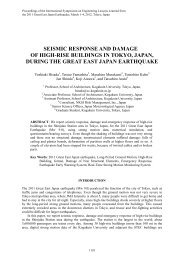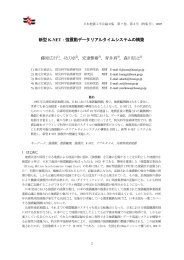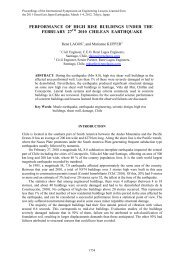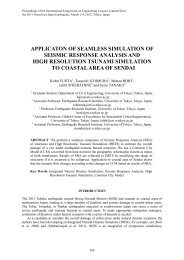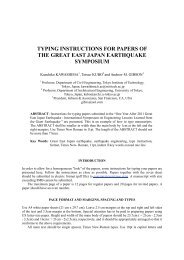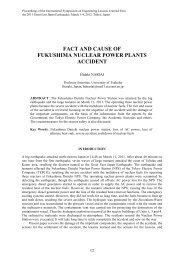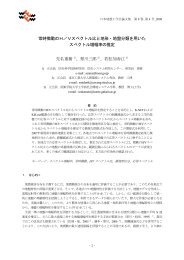Seismic Response Analysis of a Semi-active-controlled Base ...
Seismic Response Analysis of a Semi-active-controlled Base ...
Seismic Response Analysis of a Semi-active-controlled Base ...
You also want an ePaper? Increase the reach of your titles
YUMPU automatically turns print PDFs into web optimized ePapers that Google loves.
Proceedings <strong>of</strong> the International Symposium on Engineering Lessons Learned fromthe 2011 Great East Japan Earthquake, March 1-4, 2012, Tokyo, JapanSEISMIC RESPONSE ANALYSIS OF ASEMI-ACTIVE-CONTROLLED BASE-ISOLATEDBUILDING DURING THE 2011 GREAT EAST JAPANEARTHQUAKEKosuke NAKAJIMA 1 , Nicolas GIRON 1 , Masayuki KOHIYAMA 1 ,Keisuke WATANABE 1 , Minako YOSHIDA 1 , Masayuki YAMANAKA 2 ,Satoru INABA 2 , and Osamu YOSHIDA 21Graduate School <strong>of</strong> Science and Technology, Keio University, Kanagawa, Japan,na6061ko6041@z7.keio.jp2Obayashi Corporation, Minato-ku, Tokyo, JapanABSTRACT:The dynamic properties are examined for a university building with a semi-<strong>active</strong> baseisolation system during the 2011 Great East Japan earthquake. First, the natural periods,damping factors, and mode shapes are identified using an ARX model and the N4SIDmethod based on the observation records <strong>of</strong> the main shock <strong>of</strong> this earthquake, in whichthe building performed as a passive base isolation system due to a maintenance work.Then, the stiffness and damping coefficients <strong>of</strong> the building are identified using the samerecords. Finally, the performances <strong>of</strong> the semi-<strong>active</strong> base isolation system are analyzedusing an aftershock record based on a response simulation <strong>of</strong> the identified model.Key Words: base isolation system, Great East Japan earthquake, system identification,semi-<strong>active</strong> controlINTRODUCTIONSousoukan, a nine-story university building at Keio University, which was completed in 2000, has asemi-<strong>active</strong> base isolation system (Yoshida 2001). During the 2011 Great East Japan earthquake, thesemi-<strong>active</strong> system was not in service due to a maintenance work, and the building performed as apassive base isolation system. When the main shock <strong>of</strong> the earthquake occurred on March 11, 2011,numbers <strong>of</strong> engineers worked in the base isolation layer for the inspection <strong>of</strong> the semi-<strong>active</strong> baseisolation system; fortunately, none <strong>of</strong> them were injured. Only slight damage was found in a bridgebetween Sousoukan and a neighboring RC building etc, and thus the response <strong>of</strong> the building seems tobe effectively reduced by the base isolation system. It should be noted that falling <strong>of</strong> stored contentswere not reported in the building whereas it was observed in an adjacent library building.This paper focuses on the identification <strong>of</strong> dynamic properties <strong>of</strong> the system using the datacollected during the Great East Japan earthquake. Three types <strong>of</strong> system identification methods wereemployed, an ARX mode (Mita 2003), the N4SID method (Van Overschee and De Moor 1994), and a1025
direct optimization method <strong>of</strong> structural parameters to minimize an error in a response time history(hereafter Direct method). The natural periods and damping factors <strong>of</strong> the system are identified and thestructural parameters, i.e. stiffness and damping coefficients, are updated from those assumed indesign. As the amplitude and the duration <strong>of</strong> this earthquake are abnormally important, the accuracy <strong>of</strong>the identification is improved by neglecting measure noises and using the large available quantity <strong>of</strong>data.Then, using the identified model, the performance <strong>of</strong> the semi-<strong>active</strong> base isolation system isanalyzed based on a response simulation with based on a record <strong>of</strong> an aftershock <strong>of</strong> April 7, 2011,during which the semi-<strong>active</strong> system is considered to be activated.BUILDING INFORMATIONFigure 1 shows the section views <strong>of</strong> Sousoukan. The locations <strong>of</strong> the isolation bearings are depicted inthe left diagram. The isolation layer is composed <strong>of</strong> 65 laminated rubber bearings, 24 passivehydraulic dampers and 8 semi-<strong>active</strong> dampers. The damping coefficient <strong>of</strong> the semi-<strong>active</strong> damperscan be switched between four stages. The right diagram shows the framing system <strong>of</strong> the building,which consists <strong>of</strong> steel, steel reinforced concrete and concrete filled steel tube. The building has ninelayers: seven floors above the ground and two basement floors. The short side direction <strong>of</strong> the buildingis shifted with 25 degrees from the north-south direction as shown in Fig. 1. In this paper, however, wecall the short side direction as the NS direction.There are two independent seismic observation systems in the building: one is for control <strong>of</strong> thesemi-<strong>active</strong> system and the other is for research. The accelerometers are placed at the foundation slab,the 2nd basement, the 1st and the 7th floors as well as the ground near the building. Design structuralparameters are presented in Table 7 <strong>of</strong> the appendix.NFig. 1 Section views <strong>of</strong> SousoukanESTIMATION OF DYNAMIC PROPERTIES WITH ARX MODEL AND N4SID METHODFirst, we estimated the 1st and 2nd natural periods, natural frequencies and damping factors <strong>of</strong> theentire building and the superstructure <strong>of</strong> the building from the accelerograms <strong>of</strong> the main shock (Fig.2) using an ARX model. The acceleration records at the foundation slab are used as input, and those atthe 7th floor as output. The acceleration records between 100 and 150 s, in which large amplitude <strong>of</strong>the principal shock is observed, are used for the estimation. The number <strong>of</strong> poles, the number <strong>of</strong> zeropoints, and dead time are set to 12, 4, and 1 respectively. In the analysis, all the accelerograms andother records are filtered by a third order Butterworth high pass filter with a cut-<strong>of</strong>f frequency <strong>of</strong> 0.125Hz considering causality. Tables 1 and 2 show the identified results for the entire building and the1026
superstructure, respectively.Then, the 1st and 2nd natural frequencies and damping factors <strong>of</strong> the entire building are alsoidentified using the N4SID method. The acceleration records at the foundation slab were employed forinput, and those <strong>of</strong> the 2nd basement, the 1st floor, and the 7th floors for output. The accelerationrecords <strong>of</strong> three time windows: between 20 and 60 s, between 100 and 150 s (the principal shock), andbetween 200 and 300 s, were used for estimations. The dimension <strong>of</strong> the state space model was 18 forthe EW direction and 17 for the NS direction. The identified results are shown in Table 3. Similarly,the 1st and 2nd natural frequencies and damping factors <strong>of</strong> the superstructure <strong>of</strong> the building wereestimated; the dimension <strong>of</strong> the state space model is 18 for the EW direction and 16 for the NSdirection. The identified results are shown in Table 4. The mode shapes are depicted in Fig. 3.1007th floor NS1007th floor EW[cm/s 2 ]00-1000 200 400 600 [s]1st floor NS100-1000 200 400 600 [s]1st floor EW100[cm/s 2 ]00-1000 200 400 600 [s]2nd basement NS100-1000 200 400 600 [s]2nd basement EW100[cm/s 2 ]00-1000 200 400 600 [s]Foundation slab NS100-1000 200 400 600 [s]Foundation slab EW100[cm/s 2 ]00-1000 200 400 600 [s]-1000 200 400 600 [s]Fig. 2 Observed records <strong>of</strong> the main shockTable 1 Estimated system parameters for the entire building based on an ARX modelDirection Mode Natural period [s] Natural frequency [Hz] Damping factorNS 1st 3.2 0.31 0.19direction 2nd 0.68 1.5 0.17EW 1st 3.1 0.32 0.24direction 2nd 0.71 1.4 0.16Table 2 Estimated system parameters for the superstructure <strong>of</strong> the building based on an ARX modelDirection Mode Natural period [s] Natural frequency [Hz] Damping factorNS 1st 1.1 0.91 0.05direction 2nd 0.36 2.8 0.08EW 1st 1.1 0.91 0.022direction 2nd 0.37 2.7 0.041027
Table 3 Estimated system parameters <strong>of</strong> the entire building based on the N4SID methodDirection ModeNatural Frequency [Hz]Damping factor20-60 s 100-150 s 200-300 s 20-60 s 100-150 s 200-300 sNS 1st 0.48 0.31 0.32 0.141 0.180 0.132direction 2nd 1.66 1.42 1.49 0.110 0.0626 0.303EW 1st 0.48 0.31 0.32 0.263 0.166 0.158direction 2nd 1.46 1.38 1.41 0.110 0.0760 0.0782Table 4 Estimated system parameters <strong>of</strong> the superstructure <strong>of</strong> the building based on the N4SID method7th floorDirection ModeNatural Frequency [Hz]Damping factor20-60 s 100-150 s 200-300 s 20-60 s 100-150 s 200-300 sNS 1st 1.13 0.86 0.83 0.043 0.019 0.050direction 2nd 2.15 2.12 2.91 0.036 0.067 0.057EW 1st 1.04 0.90 0.83 0.037 0.081 0.040direction 2nd 2.70 2.51 2.70 0.024 0.099 0.0531st floor<strong>Base</strong>isolationlayer1st mode 2nd mode 1st mode 2nd modea) NS direction b) EW directionFig. 3 Estimated 1st and 2nd mode shapes for the time interval from 100 to 150 s(solid: real, dashed: imaginary)RESTORING FORCE PROPERTIES OF THE ISOLATION LAYERThe restoring force properties <strong>of</strong> the isolation layer are calculated. Since relative displacementsrecords were not measured in the main shock, the relative displacements <strong>of</strong> the isolation layer arederived based on acceleration records at the foundation slab and the 2nd basement floor using doubleintegral and a Butterworth filter considering causality. The Lissajous figure <strong>of</strong> the relativedisplacements <strong>of</strong> the isolation layer is indicated in Fig. 4.1028
The restoring force is approximated by the acceleration at the 2nd basement floor multiplied bythe mass <strong>of</strong> the superstructure. The Figs. 5 and 6 describe the restoring forces for every 10 seconds.The degradation <strong>of</strong> stiffness is observed after and before the principal shock.105短 辺 [cm]0-5-10-10 -5 0 5 10長 辺 [cm]Displacement in the EW direction [cm]Fig. 4 Lissajous Figure[ N ]x 10 9 0s-10s10-1-10 0 10[ cm ][ N ]x 10 9 10s-20s10-1-10 0 10[ cm ][ N ]x 10 9 20s-30s10-1-10 0 10[ cm ][ N ]x 10 9 30s-40s10-1-10 0 10[ cm ][ N ]x 10 9 40s-50s10-1-10 0 10[ cm ][ N ]x 10 9 50s-60s10-1-10 0 10[ cm ][ N ]x 10 9 60s-70s10-1-10 0 10[ cm ][ N ]x 10 9 70s-80s10-1-10 0 10[ cm ][ N ]x 10 9 80s-90s10-1-10 0 10[ cm ][ N ]x 10 9 90s-100s10-1-10 0 10[ cm ][ N ]x 10 9 100s-110s10-1-10 0 10[ cm ][ N ]x 10 9 110s-120s10-1-10 0 10[ cm ][ N ]x 10 9 120s-130s10-1-10 0 10[ cm ][ N ]x 10 9 130s-140s10-1-10 0 10[ cm ][ N ]x 10 9 140s-150s10-1-10 0 10[ cm ][ N ]x 10 9 150s-160s10-1-10 0 10[ cm ][ N ]x 10 9 160s-170s10-1-10 0 10[ cm ][ N ]x 10 9 170s-180s10-1-10 0 10[ cm ][ N ]x 10 9 180s-190s10-1-10 0 10[ cm ][ N ]x 10 9 190s-200s10-1-10 0 10[ cm ][ N ]x 10 9 200s-210s10-1-10 0 10[ cm ][ N ]x 10 9 210s-220s10-1-10 0 10[ cm ][ N ]x 10 9 220s-230s10-1-10 0 10[ cm ][ N ]x 10 9 230s-240s10-1-10 0 10[ cm ][ N ]x 10 9 240s-250s10-1-10 0 10[ cm ][ N ]x 10 9 250s-260s10-1-10 0 10[ cm ][ N ]x 10 9 260s-270s10-1-10 0 10[ cm ][ N ]x 10 9 270s-280s10-1-10 0 10[ cm ][ N ]x 10 9 280s-290s10-1-10 0 10[ cm ][ N ]x 10 9 290s-300s10-1-10 0 10[ cm ]Fig. 5 Restoring force properties <strong>of</strong> the isolation layer in the NS direction1029
x 10 9 [ cm ]x 10 9 [ cm ]x 10 9 [ cm ]x 10 9 [ cm ]x 10 9 [ cm ]0s-10s10s-20s20s-30s30s-40s40s-50s11111[ N ]0-1[ N ]0-1[ N ]0-1[ N ]0-1[ N ]0-1-10 -5 0 5 10-10 -5 0 5 10-10 -5 0 5 10-10 -5 0 5 10-10 -5 0 5 10x 10 9 [ cm ]x 10 9 [ cm ]x 10 9 [ cm ]x 10 9 [ cm ]x 10 9 [ cm ]50s-60s60s-70s70s-80s80s-90s90s-100s11111[ N ]0-1-10 -5 0 5 10[ N ]0-1-10 -5 0 5 10[ N ]0-1-10 -5 0 5 10[ N ]0-1-10 -5 0 5 10[ N ]0-1-10 -5 0 5 10x 10 9 [ cm ]x 10 9 [ cm ]x 10 9 [ cm ]x 10 9 [ cm ]x 10 9 [ cm ]100s-110s110s-120s120s-130s130s-140s140s-150s11111[ N ]0-1[ N ]0-1[ N ]0-1[ N ]0-1[ N ]0-1-10 -5 0 5 10-10 -5 0 5 10-10 -5 0 5 10-10 -5 0 5 10-10 -5 0 5 10x 10 9 [ cm ]x 10 9 [ cm ]x 10 9 [ cm ]x 10 9 [ cm ]x 10 9 [ cm ]150s-160s160s-170s170s-180s180s-190s190s-200s11111[ N ]0-1[ N ]0-1[ N ]0-1[ N ]0-1[ N ]0-1-10 -5 0 5 10-10 -5 0 5 10-10 -5 0 5 10-10 -5 0 5 10-10 -5 0 5 10x 10 9 [ cm ]x 10 9 [ cm ]x 10 9 [ cm ]x 10 9 [ cm ]x 10 9 [ cm ]200s-210s210s-220s220s-230s230s-240s240s-250s11111[ N ]0-1[ N ]0-1[ N ]0-1[ N ]0-1[ N ]0-1-10 -5 0 5 10-10 -5 0 5 10-10 -5 0 5 10-10 -5 0 5 10-10 -5 0 5 10x 10 9 [ cm ]x 10 9 [ cm ]x 10 9 [ cm ]x 10 9 [ cm ]x 10 9 [ cm ]250s-260s260s-270s270s-280s280s-290s290s-300s11111[ N ]0-1[ N ]0-1[ N ]0-1[ N ]0-1[ N ]0-1-10 -5 0 5 10-10 -5 0 5 10-10 -5 0 5 10-10 -5 0 5 10-10 -5 0 5 10Fig. 6 Restoring force properties <strong>of</strong> the isolation layer in the EW directionSYSTEM PARAMETERS OPTIMIZATIONBy utilizing the estimated natural periods and damping ratios <strong>of</strong> the system, the structural parameters,i.e. stiffness and damping coefficients, are updated. The seismic analyses were conducted with thoseupdated parameters and compared with the observed acceleration records.Consideration <strong>of</strong> Maxwell DamperAmong the 32 dampers in the base isolation layer, eight <strong>of</strong> them, four per direction, are semi-<strong>active</strong>Maxwell dampers and as a consequence, to update correctly the structural parameters based onidentification data, the state matrix <strong>of</strong> the system is adequately transformed.xdamperxspringxcMaxwellkMaxwellFig. 7 Maxwell DamperFirst, let consider the restoring force that corresponds to a Maxwell damper. As damper (c Maxwell = 0.85,1.7, 8, and 15 tf/kine) and spring (k Maxwell = 30 tf/cm) are series, they are applied the same force F and1030
the total deformation x is divided between both elements leading to the following equations:kMaxwellF = Fdamper = Fspringand x = xdamper+ xspring⇒ F& = kMaxwellx&− F (1)cMaxwellConsidering the particular case when Maxwell dampers are only installed at the base isolation layer,the state equation <strong>of</strong> the system can be restated as:with⎡MO 0⎤⎡1⎤A X&+ BX =⎢ ⎥⎢⎥&⎢O O 0⎥⎢0⎥x& g(2)⎢⎣0 0 0⎥⎦⎢⎣0⎥⎦⎡OA =⎢⎢M⎢⎣0− kMCmaxwell× δT10⎤0⎥⎥,1⎥⎦⎡⎢−M⎢B = ⎢ O⎢⎢0⎣OK004δkc1maxwellmaxwell⎤⎥⎥⎥⎥⎥⎦and⎡ x&⎤X =⎢⎢x ,⎢ ⎥ ⎥⎥ ⎣F⎦⎡1⎤⎢ ⎥⎢0δ ⎥1= (3)⎢M⎥⎢ ⎥⎣0⎦where M, C and K are the mass, damping, and stiffness matrices, respectively; x and & x& grelative displacement vector and the ground acceleration.Direct Identification Methodare theRather than identifying the natural periods and damping ratios <strong>of</strong> the system, it is possible to directlyestimate the structural parameters by defining a measure <strong>of</strong> the error e between outputs time histories<strong>of</strong> the original system y and the estimated system y m . As story masses are supposed to be correctlyestimated at the design stage, and only inter story stiffness k and damping coefficients c are updated.During strong ground motions, primary concern is given to the maximum value <strong>of</strong> drift andacceleration; thus the error e is defined to give much importance to the approximation <strong>of</strong> peak values.outputtime11e = ∑ ∑ ( yij− ym,ij ) yij(4)n n mean( y )outputni= 1 time ij j=1jConsequently the values <strong>of</strong> k and c are obtained by minimizing e. This measure can also be used tocompare this identification method with an ARX model and the N4SID method. The natural periodsand damping ratios corresponding to the direct identification are given in appendix.Updated ParametersThe updated structural parameters are also obtained by using the ARX and N4SID results. The updateis realized by optimizing K and C matrices, so that the natural periods and damping ratios calculatedfrom the complex eigenvalues analysis (Eq. 5) <strong>of</strong> the A-B system <strong>of</strong> Eq. (3) are similar to the results <strong>of</strong>the ARX and the N4SID identifications.ΩA + B = 0 , n = Ωnω , n = − Re( Ω n ) Ω nUpdated stiffness and damping coefficients are depicted on Figs. 8 and 9.nξ (5)1031
1098710987InitialARXN4SIDDirectstory65story6544332210 2 410 1 2 3stiffness [N/m]x 10 9damping [Ns/m]x 10 7a) Stiffness b) DampingFig. 8 Updated stiffness and damping coefficients in the NS direction1098710987InitialARXN4SIDDirectstory65story6544332210 2 410 1 2 3stiffness [N/m]x 10 9damping [Ns/m]x 10 7a) Stiffness b) DampingFig. 9 Updated stiffness and damping coefficients in the EW direction1032
<strong>Seismic</strong> <strong>Response</strong> <strong>Analysis</strong><strong>Seismic</strong> response analyses with updated structural parameters are conducted for two seismic events:the main shock and the aftershock that occurred 30 minutes later. The acceleration response spectra <strong>of</strong>the records observed at the foundation slab are shown in Fig. 10.All three identifications are realized using the main shock data and their accuracy is checked usingthe aftershock data. Considering the identification measure error e, the three methods are comparedand the results are summarized in Table 5. Also, a time history portion is displayed in Fig. 11 to figureout the accuracy <strong>of</strong> identification. According to those results, the direct identification method gives thebest and most robust approximation; however, the computation time is more extensive.SA [cm/s 2 ]18016014012010080604020p p (ξ )main shockafter-shock00 2 4 6 8 10Period [s]300250a) NS directiong p p ξmain shockafter-shockSA [cm/s 2 ]2001501005000 2 4 6 8 10Period [s]b) EW directionFig. 10 Acceleration response spectra <strong>of</strong> the main shock and the 30-minute-later aftershockTable 5 Error eMain ShockAftershockIdentificationNS direction EW direction NS direction EW directionMethod[10 -3 ][10 -3 ][10 -3 ][10 -3 ]Initial 6.3 5.4 7.5 5.3ARX 2.9 2.8 2.9 2.3N4SID 4.6 3.3 5.9 3.1Direct 2.8 2.2 3.1 2.11033
806040InitialARXN4SIDDirectMeasuredacceleration [cm/s 2 ]200-20-40-60-80-100132.5 133 133.5 134 134.5 135 135.5 136 136.5time [s]Fig. 11 Comparison <strong>of</strong> time histories for the main shock 7F EW directionSEMI-ACTIVE SYSTEMThe semi-<strong>active</strong> system control force is derived by the LQG theory and then divided into four dampingcoefficient gains for the Maxwell damper. Figure 12 shows time history <strong>of</strong> the damping coefficientcalculated from the record <strong>of</strong> the control signal during the April 7, 2011 aftershock. As the LQG theoryrelies on structural parameters <strong>of</strong> the building to be <strong>controlled</strong>, the results obtained through theprevious identifications are expected to improve significantly the system response. However, at thetime <strong>of</strong> this study, only performances <strong>of</strong> the control method using the structural parameters at designstage are evaluated. The simulation results are compared among three control cases: 1) the lowestdamping coefficient is given to the semi-<strong>active</strong> dampers (passive low), 2) the highest dampingcoefficient is given to them (passive high), and 3) the time history <strong>of</strong> the damping coefficient shown inFig. 12 is applied to them (semi-<strong>active</strong>).The results for the aftershock are summarized in Table 6 and Fig. 13. Globally, the semi-<strong>active</strong>control gives the best performances; however, the difference with the passive control is very small andthus it is expected that the parameters updated in this study will improve the performances <strong>of</strong> thesemi-<strong>active</strong> control system.15C semi <strong>active</strong>[tf/kine]81.7050 52 54 56 58 60 62 64 66 68 70time [s]Fig. 12 Control gain signal1034
disp [cm]0.50-0.5passive lowpassive highsemi-<strong>active</strong>50 55 60 65 70time [s]Fig. 13 Comparison <strong>of</strong> the base isolation layer relative displacement among three control methodsTable 6 Performances <strong>of</strong> control methods (black: worst, gray: intermediate, white: best)Isolation layerIsolation layer7F accelerationControldisplacement [cm] acceleration [cm/s 2 ][cm/s 2 ]NS EW NS EW NS EWdirection direction direction direction direction directionLow 0.68 0.75 2.89 3.46 4.33 5.17High 0.42 0.47 3.39 4.03 5.57 5.91<strong>Semi</strong> 0.66 0.68 2.72 3.41 4.13 4.72CONCLUSIONSThe dynamic properties <strong>of</strong> the semi-<strong>active</strong> base isolation system <strong>of</strong> a university building wereinvestigated based on observed records during the 2011 Great East Japan earthquake. The systemparameters were identified using an ARX model, the N4SID method, and a direct optimization methodto minimize an error in a response time history. A series <strong>of</strong> seismic response analyses were conducted,and it was confirmed that updated parameters gave more accurate estimations <strong>of</strong> the real behavior <strong>of</strong>the system compared to initial design ones. Consequently, it is expected that, in a near future, thesemi-<strong>active</strong> control system can be efficiently updated with more accurate structural parameters to <strong>of</strong>fera better control <strong>of</strong> the building.APPENDIXTable 7 Initial structural parametersFloorMass Stiffness [kN/cm] Damping coefficient [kN・s/cm][kN] NS direction EW direction NS direction EW directionRF 24500 11956 9996 100.80 80.4877 20246 12936 11564 109.06 93.1106 19962 14994 13818 126 111.265 19962 15778 15680 133.03 126.254 20090 17150 18130 144.60 145.983 19923 17248 18032 145.42 145.202 17894 17738 19796 149.56 159.401 24411 19796 27636 166.90 222.52B1 33692 19796 22736 166.90 183.1B2 48813 668.4 668.4 100.0 100.01035
Table 8 Identified system characteristics <strong>of</strong> the entire buildingNS directionEW directionIdentification Natural NaturalNatural NaturalModeDampingDampingMethodperiod frequencyperiod frequencyfactorfactor[s] [Hz][s] [Hz]Initial2.58 0.39 9% 2.56 0.39 7%ARX 3.20 0.35 19% 3.10 0.36 24%1stN4SID 3.23 0.31 18% 3.23 0.31 17%Direct 3.25 0.31 14% 3.21 0.31 16%Initial0.77 1.29 9% 0.77 1.30 7%ARX 0.68 1.47 17% 0.71 1.41 16%2ndN4SID 0.70 1.42 6% 0.72 1.38 8%Direct 0.71 1.41 9% 0.72 1.38 8%Table 9 Identified system characteristics <strong>of</strong> the superstructureNS directionEW directionIdentification Natural NaturalNatural NaturalModeDampingDampingMethodperiod frequencyperiod frequencyfactorfactor[s] [Hz][s] [Hz]Initial1.32 0.76 2% 1.26 0.79 2%ARX 1.10 0.91 5% 1.10 0.91 2%1stN4SID 1.16 0.86 2% 1.11 0.90 8%Direct 1.18 0.85 2% 1.20 0.83 2%Initial0.48 2.10 6% 0.47 2.11 5%ARX 0.36 2.80 8% 0.37 2.70 4%2ndN4SID 0.47 2.12 7% 0.40 2.51 10%Direct 0.44 2.27 7% 0.45 2.22 4%REFERENCESMita, A. (2003). “Health Monitoring and Identification.” Structural Dynamics for Health Monitoring,Chap. 5, 84-96.Van Overschee, P. and De Moor, B. (1994). “N4SID: Subspace Algorithms for the Identification <strong>of</strong>Combined Deterministic-Stochastic Systems.” Automatica, Vol. 30, No. 1, 75-93.Yoshida, K. (2001). “First Building with <strong>Semi</strong>-Active <strong>Base</strong> Isolation.” Journal <strong>of</strong> the Japan Society <strong>of</strong>Mechanical Engineers, Vol. 104, No. 995, 698-702.1036




